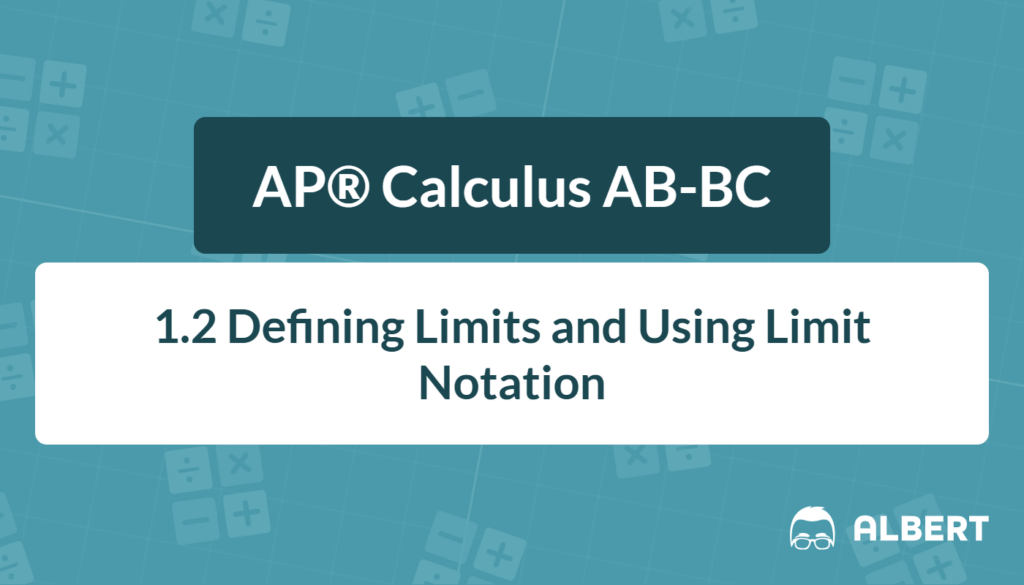What height does a bouncing ball settle toward after many rebounds? That target height is never quite reached, yet it can be predicted. Mathematically, it is the value that a function approaches as time goes on. The language used to describe this idea is called limit notation.
Limits sit at the heart of derivatives and integrals, so the College Board dedicates two learning objectives to them—LIM-1.A.1 and LIM-1.B.1. Therefore, this lesson explains what a limit is, decodes the notation, presents three common representations, and highlights pitfalls that appear on both the AP® Calculus AB and BC exams.
What We Review
What Exactly Is a Limit?
Plain-language definition
A limit is the single number a function gets closer and closer to as its input gets closer and closer to some chosen point.
Formal statement
Using limit notation, this idea reads
\displaystyle \lim_{x\to c} f(x)=Land is read “the limit of f of x as x approaches c equals L.”
Everyday analogy
Imagine walking toward a door but never stepping through it. Each step halves the remaining distance. Although the door is never reached, the walking position approaches a definite spot—the door’s threshold. That spot is the limit.
Step-by-step Example 1
Evaluate \displaystyle \lim_{x\to 3}(2x+1).
- Substitute x = 3 directly because the expression is continuous.
- 2(3)+1=7
- Therefore, the function can be made arbitrarily close to 7 by taking x sufficiently close to 3.
Answer: 7
Quick Practice: Find \displaystyle \lim_{x\to-2}(5x-4).
Solution: Substitute to get 5(-2)-4=-14.
Cracking the Code: Limit Notation Explained
Anatomy of \displaystyle \lim_{x\to c} f(x)=L
- lim signals “take the limit.”
- The arrow x → c shows the approach value.
- f(x) is the function itself.
- L is the number being approached.
One-sided limits
Sometimes, only one side matters:
\lim_{x\to c^-}f(x) (approach from the left) \lim_{x\to c^+}f(x) (approach from the right)Infinite limits and limits at infinity
If f(x) grows without bound near c, write
\displaystyle \lim_{x\to c}f(x)=\infty.If x itself heads to infinity, use
\displaystyle \lim_{x\to\infty}f(x)=L.Step-by-step Example 2
Find \displaystyle \lim_{x\to0}\frac{\sin x}{x}.
- Direct substitution gives 0⁄0, an indeterminate form.
- On the unit circle, sin x is trapped between x and tan x. Therefore, by the Squeeze Theorem, \displaystyle \lim_{x\to0}\frac{\sin x}{x}=1.
Answer: 1
Mini-summary
- Limit notation precisely records the value that a function approaches.
- One-sided limits test direction.
- Infinite limits describe unbounded growth.
Three Ways to Represent a Limit
Graphical View
A graph reveals holes, jumps, and vertical asymptotes quickly.
Example 3 (graph description):
A piecewise curve follows y = x except at x = 2, where an open circle (hole) appears at (2, 2) and a solid dot is plotted at (2, 5). The y-value approached on both sides is 2, so
\displaystyle \lim_{x\to2}f(x)=2…even though f(2)=5. This is a removable discontinuity.
Numerical (Table) View
Creating a table near c suggests the approaching value.
Example 4: Evaluate \displaystyle \lim_{x\to0}\frac{\sqrt{x+1}-1}{x} numerically.
| x | –0.01 | –0.001 | 0.001 | 0.01 |
| f(x) | 0.499 | 0.4999 | 0.5001 | 0.501 |
Numbers hover around 0.5, so the limit appears to be 0.5.
Analytical (Algebraic) View
Algebra often gives exact answers.
Common tactics
- Direct substitution
- Factoring & canceling
- Rationalizing
- Special trig limits
Example 5: Evaluate \displaystyle \lim_{x\to2}\frac{x^{2}-4}{x-2}.
- Factor numerator: x^{2}-4=(x-2)(x+2).
- Cancel the common factor: \frac{(x-2)(x+2)}{x-2}=x+2 for x ≠ 2.
- Substitute: 2 + 2 = 4.
Answer: 4
Pros & Cons Quick List
- Graphical: easy to see behavior; however, scale may mislead.
- Numerical: useful when algebra is messy; nevertheless, rounding error exists.
- Analytical: provides exact value; yet, requires algebraic skill.
When Limits Do Not Exist
Some functions never settle on a single number.
- Jump discontinuity – two one-sided limits differ.
- Infinite limit – graph shoots upward or downward without bound.
- Oscillation – function wiggles faster and faster.
Example 6: \displaystyle \lim_{x\to0}\frac{1}{x}
Approaching from the left gives –∞, while from the right gives ∞. Because the left and right limits disagree, the two-sided limit does not exist.
Why Limits Matter in AP® Calculus
Limits build directly into the formal derivative:
\displaystyle f'(x)=\lim_{h\to0}\frac{f(x+h)-f(x)}{h}.Moreover, the Fundamental Theorem of Calculus relies on limit processes to connect areas with antiderivatives. On the AP® exam, roughly 10–12 % of multiple-choice questions and frequent FRQ parts require fluent use of limit notation. Therefore, practicing all three representations increases flexibility.
Quick Reference Chart: Key Vocabulary & Definitions
| Term | Definition | Simple Example |
| Limit | The value that a function approaches as x nears a point | \lim_{x\to3}2x=6 |
| Limit notation | Symbolic form \lim_{x\to c}f(x)=L | \lim_{x\to2}\frac{x^{2}-4}{x-2}=4 |
| One-sided limit | Limit from only the right (⁺) or left (⁻) | \lim_{x\to1^-}f(x) |
| Removable discontinuity | Hole where limit exists but function value is missing or different | \lim_{x\to2}f(x)=2 while f(2)\neq2 |
| Infinite limit | Function grows without bound near c | \lim_{x\to0}\frac{1}{x}=\infty |
| Limit at infinity | Value a function approaches as x→∞ | \lim_{x\to\infty}\frac{1}{x}=0 |
| Continuous function | Function with no breaks; limit equals value | \lim_{x\to5}(x^{2}+1)=26 |
Conclusion
A limit captures the single value that a function approaches as the input closes in on a target. Mastering limit notation—graphically, numerically, and analytically—builds a sturdy foundation for derivatives and integrals on both AP® Calculus exams. Next, explore derivative rules to see how limits power every slope formula encountered in calculus.
Sharpen Your Skills for AP® Calculus AB-BC
Are you preparing for the AP® Calculus exam? We’ve got you covered! Try our review articles designed to help you confidently tackle real-world math problems. You’ll find everything you need to succeed, from quick tips to detailed strategies. Start exploring now!
Need help preparing for your AP® Calculus AB-BC exam?
Albert has hundreds of AP® Calculus AB-BC practice questions, free responses, and an AP® Calculus AB-BC practice test to try out.








